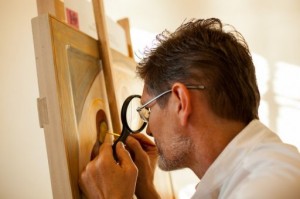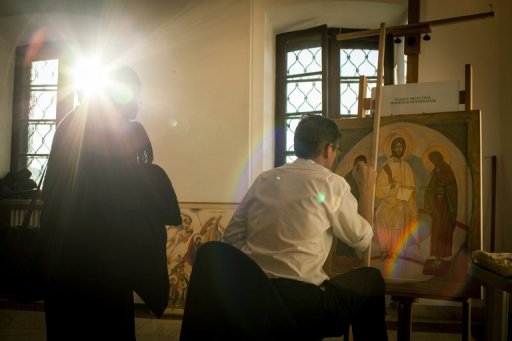MOGOSOAIA, Romania — With brighter hues and bolder brushstrokes, Orthodox icon painters are looking to breathe new life into the ancient art of depicting saints, angels and biblical scenes, lest its rigid rules see it consigned to history.

US painting professor Anthony Salzman was among a dozen church painters who gathered in Romania (AFP, Andrei Pungovschi)
A dozen church painters from European countries like Greece and Serbia but also from the United States recently gathered in Romania to experiment with adding modern touches to Byzantine iconography without angering the conservative Orthodox Church.
“I don’t want to attack them,” US painting professor Anthony Salzman said of churchgoers, “but I don’t want to bore them either”.
“Tradition died in the 16th or 17th century, now we are resurrecting it, we are learning what its limits are,” he added at the event in Mogosoaia, on the outskirts of Bucharest.
Icons, which are displayed in churches, monasteries and homes, play a key role in the Orthodox faith, whose faithful kiss them and expect miracles and cures.
The practice is subject to strict canons, with church rules dictating what the painters can and cannot do.
Some of today’s painters think that sticking to the rules will bury rather than perpetuate icon-making, which is why they are playing around with new styles.
Some are making the figures more abstract, the faces less sombre or the colours more vivid.
“Innovation keeps tradition alive, otherwise just copying the past is not functioning,” said Georgios Kordis, the head of the Eikona group that organised the event.
“There are many things that you can introduce – the quality of lines, the colour, the composition,” he said.
Sitting in front of his easel, in the impressive 18th-century Mogosoaia Palace, the Greek professor of Orthodox theology carefully paints halos around the heads of three saints that are coming alive on the wooden board.
Behind him, several young nuns are carefully taking notes, hoping to transpose what they see to their own works.
“I started painting icons some months ago but I want to get better,” Mother Mihaela said.
Like her, many Romanian nuns but also fine arts students feel increasingly drawn to painting icons either to express their faith or to earn some money in a country where nearly 90 percent of inhabitants declare themselves as Orthodox.
But several painters present said their works were sometimes met with hostility by church dignitaries or believers who thought them to be “too bold.”
“Painting is dynamic, you have to be bold,” insisted Grigore Popescu, a Romanian icon painter and restorer whose works adorn dozens of churches and monasteries in Romania but also in France and Germany.
Young or old, the artists said they were seeking the middle road that allows icons to keep pace with the changing world all while satisfying the Church’s demands.
“We cannot run too far ahead of the Church but we cannot leave it where it is either,” said Salzman, the US painting professor, who embraced Orthodoxy and was ordained priest a few years ago.
“People think differently, so we have to speak to them differently or they would not understand.”
Todor Mitrovic, a professor at the Fine Arts Academy in Belgrade, said he was “obsessed with finding the balance between tradition and innovation”.
“The Church is afraid to lose it (tradition) but it cannot put it in chains. To keep it alive, you have to let artists explore,” he said.
One of his students, Slavica Mihailova from Macedonia, said that bringing in modern elements such as different colours does not necessarily mean straying from tradition.
“Continuing to make copies is as if you had nothing to say. You have to put something of yourself in an icon.”
“Icons are the visual proof of our faith, they make believers feel that Christ and the saints are present,” Kordis said.
“If icons don’t stir any emotion, Christians will have no dialogue with them.”
Source: AFP














